You can find this post here on my new site for the full post and to leave comments.
Passive hydroponics, semi-hydroponic growing, and a number of other names refer to a method of growing in which an inert porous medium such as hydroton, PrimeAgra or even perlite and vermiculite (apparently). Water in a reservoir is then wicked through this medium to the plant roots which are supplied a constant amount of water and fertilizer and are then able to grow without the challenges of soaking and drying and similarly questionable feeding practices.
I briefly mentioned that I would be moving my NOID Phal. into Semi-Hydroponic culture. Growth so far since the move back at the end of December has been... fairly slow actually. It's winter though, not really the best time to be transplanting orchids by any stretch but circumstances made re-potting necessary and being free, though I'd hate to lose it, this orchid was a perfect candidate. I also did not cut off the developing spike which has grown well (though most recommend for the health of the plant to remove things like flower spikes). At least there's been minimal root loss which makes it a win (so far) in my books, though a few roots are mushy and need cleaning.
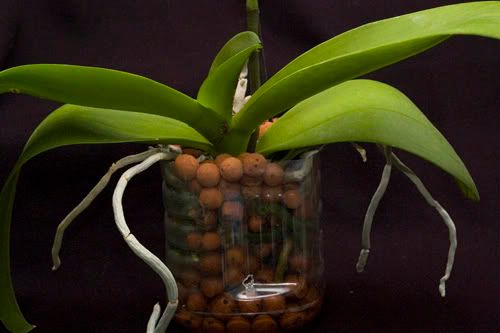
NOID Phal. - So far so good. You can see the holes near the bottom of the pot - the reservoir is below these, good airflow above.
I went to my nearest hydroponics store and picked up a small bag of hydroton, a type of expanded clay pellet, and re-potted the plant in it in a home-made pot. My (strong) preference is a clear pot so you can easily see what's going on (see picture above). Basically I took the bottom of a juice container (started stocking up on large deli containers though for future re-potting), poked two small holes at the bottom about an inch up for drainage. After soaking the hydroton for 24 hours I filled the pot to those holes with the hydroton, then re-potted the orchid (all moss etc cleaned off the roots) in the usual manner, tapping the pot regularly to get the hydroton in and around all the roots - because you're relying on capillary action to wick water from the reservoir up it's important that it's touching enough to be able to manage that. Once potted fill your pot with water and let it drain - the reservoir will stay filled and, if done properly, none of the roots will be in the reservoir (yet). The hydroton will then wick water to the roots, the plant will grow and all will be well. The pot can be flushed in much the same way just by running water through it at a slow trickle where the pot fills as fast as it drains and letting the water run for a while.
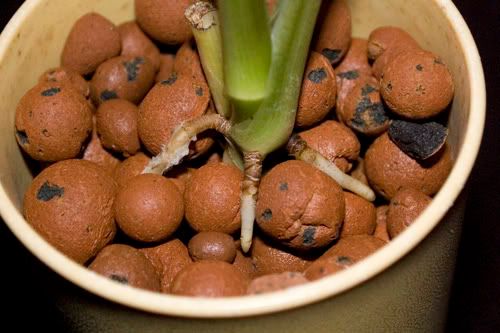
Syngonium sp. - cutting was placed in a full cup of water and hydroton on the night of Dec. 27, 2009 - this much root growth has happened since. Now that there are good roots I've dropped the water level to just a shallow reservoir at the bottom of the cup. Since I rooted it in water in hydroton I don't really need to re-pot at any point between a rootless cutting and it filling the cup with roots.
Old roots may die off but will be replaced by more moisture tolerant roots - this is the main reason it is risky to try to adapt a plant to passive hydroponics during the winter - you need fast root growth to replace any roots that will die off. I was lucky for a number of reasons - first, the orchid had been potted in fairly wet moss so its roots were already fairly moisture tolerant and to be honest was probably getting more air around the roots than in the moss - second, the orchid had a good number of healthy air roots, even if all roots in the pot had died off I could have kept the plant alive - and third, there were some fairly new roots growing, a touch older than is recommended (i.e., just nubs) but still probably more adaptable than the oldest roots, especially since the part already grown will still be fairly dry being at the surface and the roots would then grow into the wetter conditions. I have seen some amazing pictures of orchids that are successfully growing roots in the reservoir which goes against approximately everything I've ever heard about orchids and water.
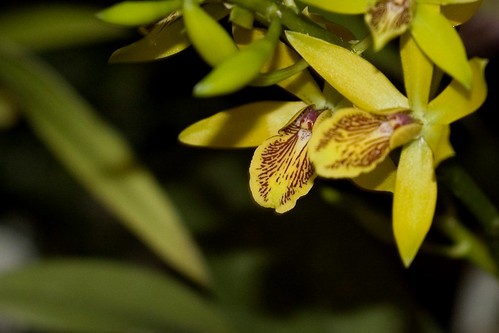
Epc. Kyogucgi (Now Guaricyclia, Gcy. Kyogucgi)
Photo taken at the SOOS Show, February 14, 2009 - I'm trying to save mine in SH culture and it looks like it'll work well.
Once new roots are growing they'll be able to handle a lot of water, the open structure and large size of the expanded clay pellets lets a lot of air around the roots and the constant supply of water makes growth steady and fairly quick. Depending on the size of your reservoir plants can apparently be watered as infrequently as every two weeks or so, or can be watered daily with no ill effects.
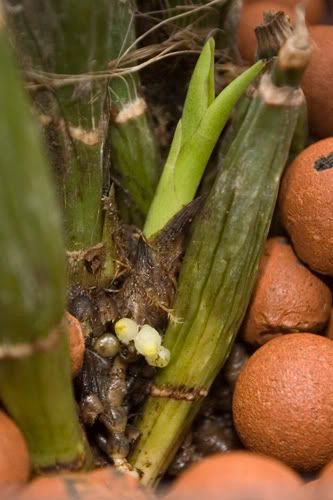
This new shoot and those three little roots are what will save this plant.
Fertilizing is only slightly more complicated. I've always tended to under-fertilize, though that will need to stop since hydroton has no nutrients at all. I read quite a bit on fertilizing orchids in semi-hydroponic culture and found that plugging numbers in here is the easiest answer. Otherwise read this, then go back to the calculator.
I use Schultz Expert Gardener Water Soluble Plant Food for Orchids (19-31-17 NPK) so according to the calculator if I shoot for a target nitrogen level of 125ppm (on the low side though more appropriate given the light I'm giving my plants) I'll need to use half a tsp of fertilizer / gallon of water (slightly less during winter, more in summer). This page talks about targeted feeding (based around nitrogen & a balanced fertilizer) at different times of the year and for different plants (such as those which normally need a rest period) and is a good read.
The theory (and practice, from the pictures I've seen) are sound and results are undeniable. My own results are after only a few weeks but there are many images out there of plants after X amount of time with before and after pictures showing root growth and flowering that are just amazing. Amazing as it may prove to be I'm going to take it slow and only move a few plants over this spring and see what results I end up with before I jump in with both feet (and many plants).
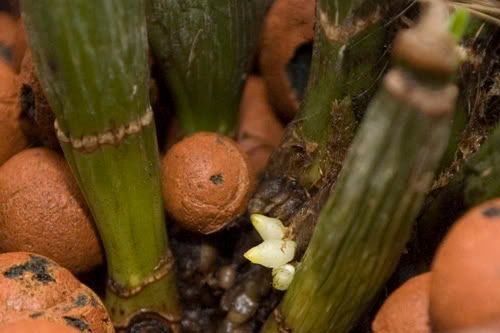
Here's another look at those new roots. Aww...
So far I have three orchids in passive hydroponic culture (the Phal above and two rescues, one Epicat. and one Paph.) and a cutting of a Syngonium sp. and I'm only out $5 for a large Ziploc bag of hydroton. I have spent $0 on fancy pots and gauges, or anything else needed for the pot-in-pot style of passive hydroponic growing and won't be spending a dollar for any more orchid bark.
In short: Proper container (my preferred is a clear plastic container with a hole or two at the top of the reservoir), appropriate medium (hydroton or similar) soaked overnight, clean roots on a actively growing plant (spring, warm conditions, maybe lower light to discourage or slow vegetative growth during this period). Pot up the plant in the prepared medium and water with a nutrient solution at an appropriate strength occasionally flushing the pot with fresh water to avoid calcium/salt buildup.
Lots more to read at First Rays & Water Roots.
You'll definitely be kept up to date on how these plants are doing as really there's not much else going on right now plant-wise. I'm just starting my spring hiatus from work which will last until March (though to be honest I'm always but especially now looking for something else) and other than an orchid show in February there's not much going on. I'm also going to try to make it out to a few Gesneriad meetings and Orchid meetings to help me pass the time/keep me busy and hopefully give me some good stuff to write about.
(For those who saw this post this morning - oops! It's up again with pictures this time - it got auto posted before I'd taken the pictures for the post.)


Thanks for the post, we will post your Cheap hydroponic article. we will post for our customers to see your articles on your blog Cheap hydroponic
ReplyDelete